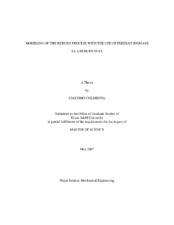| dc.description.abstract | Coal fired power plants will face many challenges in the near future as new
regulations, such as the Clear Sky Act, are being implemented. These regulations impose
much stricter limits on NOx emissions and plan to impose limits on mercury emissions
from coal fired boilers. At this time no technologies are currently being implemented for
control of Hg and this explains the strong interest in this area by the Department of
Energy (DOE).
Reburn technology is a very promising technology to reduce NOx emissions.
Previous experimental research at TAMU reported that Feedlot Biomass (FB) can be a
very effective reburn fuel, for reduction of NOx up to 90%-95%; however, little work
has been done to model such a process with Feedlot Biomass as reburn fuel. The present
work addresses the development of a reburn model to predict NOx and Hg emissions.
The model accounts for finite rate of heating of solid fuel particles, mixing with
NOx laden hot gases, size distribution, finite gas phase and heterogeneous chemistry, and
oxidation and reduction reactions for NOx and Hg. To reduce the computational effort all
the reactions, except those involved in mercury oxidation, are modeled using global
reactions. Once the model was validated by comparison with experimental findings,
extensive parametric studies were performed to evaluate the parameters controlling NOx
reduction.
From DOE research programs some experimental data regarding the capture of
mercury from power plant is available, but currently no experimental data are available
for Hg emission with reburn process. This model has shown a very large mercury
reduction using biomass as a reburn fuel.
The model recommends the following correlations for optimum reduction of
NOx: Equivalence Ratio should be above 1.05; mixing time should be below 100ms
(especially for biomass); pure air can be used as the carrier gas; the thermal power
fraction of the reburner should be between 15% and 25%; residence time should be at
least 0.5s and the Surface Mean Diameter (SMD) of the size distribution should be as
small as possible, at least below 100 µm. | en |


